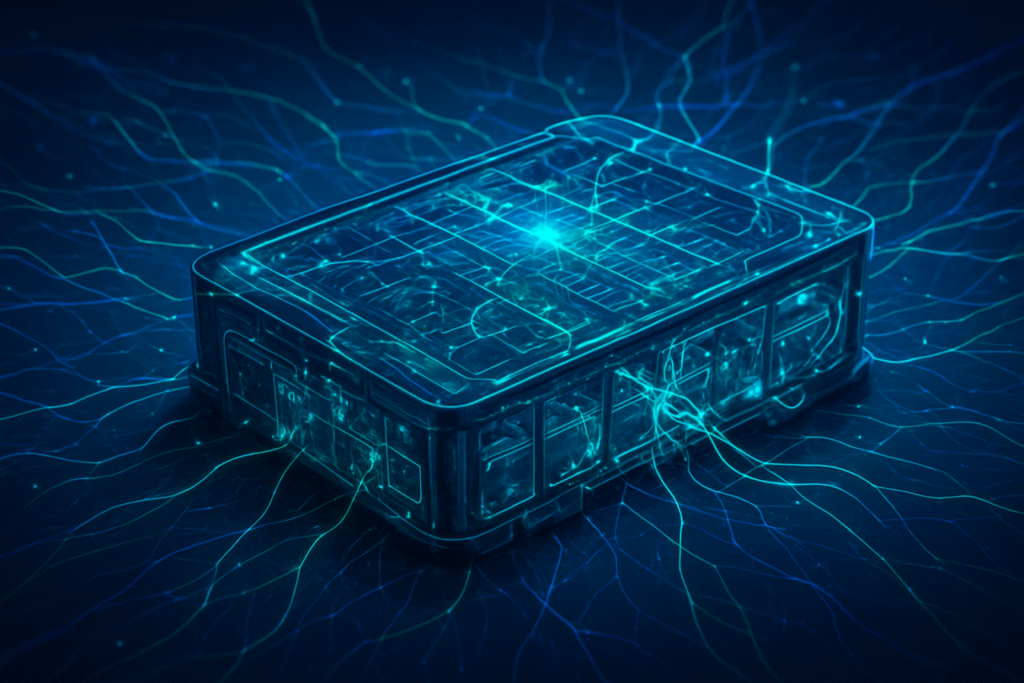
Eindhoven, Netherlands – October 31, 2025 – NXP Semiconductors (NASDAQ: NXPI) has ignited a new era in automotive innovation with the recent launch of its industry-first Electrochemical Impedance Spectroscopy (EIS) battery management chipset. This groundbreaking solution, featuring in-hardware battery cell impedance measurement, promises to profoundly enhance the safety, longevity, and performance of electric vehicles (EVs) and energy storage systems. Unveiled on October 29, 2025, the chipset brings sophisticated, lab-grade diagnostics directly into the vehicle, setting a new benchmark for battery intelligence and laying critical groundwork for the next generation of AI-driven battery management systems.
The immediate significance of NXP's announcement lies in its novel approach: integrating EIS measurement directly into the hardware of a Battery Management System (BMS) with nanosecond-level synchronization across all devices. This not only simplifies system design and reduces cost for automakers but also provides an unprecedented level of real-time, high-fidelity data, which is crucial for advanced AI/Machine Learning (ML) algorithms optimizing battery health and performance. As the global automotive industry races towards full electrification, NXP's chipset emerges as a pivotal enabler for safer, more efficient, and longer-lasting EV batteries.
Technical Prowess: Unpacking NXP's EIS Advancement
NXP's EIS battery management chipset is a comprehensive system solution meticulously engineered for precise and synchronized measurement across high-voltage battery packs. The core of this innovation is its three primary devices: the BMA7418 cell sensing device, the BMA6402 gateway, and the BMA8420 battery junction box controller. The BMA7418, an 18-channel Li-Ion cell controller IC, is particularly noteworthy for its dedicated, high-accuracy Analog-to-Digital Converter (ADC) per voltage measurement channel, enabling the nanosecond-level synchronization critical for EIS. It boasts an integrated Discrete Fourier Transform (DFT) per channel, a typical measurement error of ±0.8 mV, and achieves Automotive Safety Integrity Level (ASIL) D functional safety.
This hardware-based approach, featuring an integrated electrical excitation signal generator, marks a significant departure from previous battery monitoring methods. Traditional time-based measurements often fall short in detecting dynamic, millisecond-level events indicative of early battery failure. NXP's chipset, however, provides real-time, high-frequency monitoring that assesses cell impedance across various frequencies, revealing subtle internal changes like temperature gradients, aging effects, or micro short circuits. This capability, previously confined to expensive laboratory equipment, is now embedded directly into the vehicle, offering unparalleled insights into battery health and behavior.
While the chipset itself does not embed AI inferencing for the EIS functionality, its core advancement lies in generating an exceptionally rich dataset—far superior to traditional methods. This high-fidelity impedance data, combined with in-chip discrete Fourier transformation, is the lifeblood for advanced AI/ML algorithms. These algorithms can then more effectively manage safe and fast charging strategies, detect early signs of battery degradation with greater precision, accurately estimate battery health, and distinguish between capacity fade and other issues, even under dynamic conditions. In essence, NXP's chipset acts as a foundational enabler, providing the high-quality data necessary for the next generation of sophisticated, AI-driven battery management strategies.
Initial reactions from the industry have been largely positive, with battery systems engineers viewing the integrated EIS BMS chipset as a significant step forward. Naomi Smit, NXP's VP and GM of Drivers and Energy System, emphasized that the EIS solution "brings a powerful lab-grade diagnostic tool into the vehicle" and simplifies system design by reducing the need for additional temperature sensors. She highlighted its support for faster, safer, and more reliable charging without compromising battery health, alongside offering a low-barrier upgrade path for OEMs. However, some industry observers note potential challenges, including the chipset's market launch not expected until early 2026, which could allow competitors to introduce similar technologies, and the potential complexity of integrating the new chipset into diverse existing automotive designs.
Reshaping the Competitive Landscape: Impact on Companies
NXP's EIS battery management chipset is set to send ripples across the AI and automotive industries, influencing tech giants, established automakers, and burgeoning startups alike. As the innovator of this industry-first solution, NXP Semiconductors (NASDAQ: NXPI) solidifies its leadership in automotive semiconductors and electrification solutions, enhancing its comprehensive portfolio for managing energy flow across electric vehicles, homes, and smart grids.
Electric Vehicle (EV) Manufacturers, including industry titans like Tesla (NASDAQ: TSLA), General Motors (NYSE: GM), Ford (NYSE: F), Volkswagen (ETR: VOW3), and Hyundai (KRX: 005380), are direct beneficiaries. The chipset enables them to deliver safer vehicles, extend battery range and lifespan, support faster and more reliable charging, and reduce overall system complexity and cost by minimizing the need for additional sensors. These improvements are critical differentiators in the fiercely competitive EV market. Beyond EVs, Energy Storage System (ESS) providers will gain enhanced monitoring and management capabilities for grid-scale or commercial battery storage, leading to more efficient and reliable energy infrastructure. Tier 1 Automotive Suppliers, developing and manufacturing battery management systems or complete battery packs, will integrate NXP's chipset into their offerings, enhancing their own product capabilities.
For AI and Data Analytics Firms, particularly those specializing in predictive analytics and machine learning for asset management, the NXP EIS chipset provides an invaluable new trove of high-fidelity data. This data can be used to train more accurate and robust AI models for battery prognostics, optimize charging strategies, predict maintenance needs, and enhance battery lifetime estimations. Major AI labs could focus on creating sophisticated digital twin models of batteries, leveraging this granular data for simulation and optimization. Tech giants with significant cloud AI/ML platforms, such as Google Cloud AI (NASDAQ: GOOGL), Amazon Web Services ML (NASDAQ: AMZN), and Microsoft Azure AI (NASDAQ: MSFT), stand to benefit from the increased demand for processing and analyzing this complex battery data, offering specialized AI-as-a-Service solutions to automotive OEMs. Startups focusing on AI-driven battery analytics, personalized battery health services, or optimized charging network management will find fertile ground for innovation, leveraging the "low-barrier upgrade path" for OEMs.
The competitive implications are profound. This development will drive increased demand for specialized AI talent and platforms capable of handling time-series data and electrochemical modeling. It also signals a trend towards "hardware-aware AI," pushing more processing to the edge, directly within the vehicle's hardware, which could influence AI labs to develop more efficient, low-latency models. Control and access to this high-value battery health data could become a new competitive battleground, with tech giants potentially seeking partnerships or acquisitions to integrate this data into their broader automotive or smart energy ecosystems. The chipset has the potential to disrupt traditional software-based BMS solutions and external battery diagnostic tools by bringing "lab-grade diagnostics into vehicles." Furthermore, enhanced battery health data could lead to the evolution of battery warranty and insurance models and streamline the nascent second-life battery market by allowing more precise valuation and repurposing. NXP's strategic positioning with this first-mover advantage sets a new benchmark for the industry.
A Broader Lens: Significance in the AI and Automotive Landscape
NXP's EIS battery management chipset represents a pivotal moment in the broader AI landscape, particularly concerning data generation for AI-driven systems within the automotive sector. By embedding Electrochemical Impedance Spectroscopy directly into the hardware of a high-voltage battery pack management system with nanosecond-level synchronization, NXP (NASDAQ: NXPI) is not just improving battery monitoring; it's revolutionizing the quality and granularity of data available for AI.
This rich data generation is a game-changer for fueling predictive AI models. EIS provides high-fidelity data on internal battery characteristics—such as state of health (SOH), internal resistance, and specific degradation mechanisms of individual cells—that traditional voltage, current, and temperature measurements simply cannot capture. This detailed, real-time, high-frequency information is invaluable for training and validating complex AI and machine learning models. These models can leverage the precise impedance measurements to develop more accurate predictions of battery aging, remaining useful life (RUL), and optimal charging strategies, effectively shifting battery management from reactive monitoring to proactive, predictive intelligence. This aligns perfectly with NXP's broader strategy of leveraging AI-powered battery digital twins, where virtual replicas of physical batteries are fed real-time, EIS-enhanced data from the BMS, allowing AI in the cloud to refine predictions and optimize physical BMS control, potentially improving battery performance and SOH by up to 12%. This also supports the trend of "AI at the Edge," where granular data from the battery cells can be processed by onboard AI for immediate decision-making, reducing latency and reliance on constant cloud connectivity.
The overall impacts are transformative: battery management is elevated from basic monitoring to sophisticated, diagnostic-grade analysis, leading to safer and smarter EVs. This improved intelligence translates to better EV economics by extending battery life, enabling faster charging, and reducing warranty costs for automakers. It also enhances the entire electrification ecosystem, including smart grids and energy storage systems. However, potential concerns include market timing, as competitors could introduce similar technologies before the chipset's early 2026 availability. While hardware-embedded for precision, a strong reliance on hardware might limit flexibility compared to future software-based battery management practices. Additionally, integrating a new chipset into diverse automotive designs, despite NXP's "low-barrier upgrade path," could still pose adoption challenges for OEMs.
Compared to previous AI milestones in battery technology, NXP's EIS chipset represents a crucial evolutionary step. Earlier breakthroughs focused on using AI to accelerate battery testing, discover new materials, and optimize charging algorithms based on available data. The EIS chipset significantly enriches the data input for these AI systems. It democratizes advanced diagnostics, bringing the insights once confined to research laboratories directly to the vehicle's edge. This empowers AI models to make more informed decisions, leading to enhanced safety, extended battery lifespan (potentially up to 12% improvement in performance and SoH), faster and more reliable charging, and a reduction in overall system complexity and cost for automakers. It's a foundational step that will unlock new levels of efficiency and reliability in the electrified world.
The Road Ahead: Future Developments and Predictions
The introduction of NXP's (NASDAQ: NXPI) EIS battery management chipset is not merely a product launch; it's a foundational step towards a profoundly more intelligent and efficient automotive future. With the complete solution expected to be available by early 2026, running on NXP's S32K358 automotive microcontroller, the near-term focus will be on its integration into next-generation EV platforms. This includes the BMA7418 cell sensing device, BMA6402 communication gateway, and BMA8420 battery junction box controller, all working in concert to provide hardware-based nanosecond-level synchronization of cell measurements.
Looking further ahead, the long-term developments will revolve around leveraging this rich EIS data to fuel increasingly sophisticated AI-driven battery management. NXP's broader strategy in automotive AI and software-defined vehicles suggests continued integration and enhancement, particularly through AI-powered battery digital twins. These digital twins, connected to the cloud, will utilize the high-fidelity EIS data for improved real-time prediction and control of battery performance. Future iterations will likely see increased computational power at the edge, allowing more refined AI algorithms for predictive maintenance and real-time optimization to operate directly within the vehicle, reducing latency and reliance on constant cloud connectivity. NXP's investment in ultra-wideband (UWB) technology for robust wireless BMS communication also hints at more scalable, secure, and flexible battery architectures.
Potential applications and use cases on the horizon are vast. Beyond enhanced EV safety and health through lab-grade diagnostics, the chipset will enable optimized charging and performance, supporting faster, safer, and more reliable charging without compromising battery health. It will lead to improved battery longevity and range through precise insights into battery state of health (SoH) and state of charge (SoC), potentially extending battery performance by up to 12%. For drivers, this translates to more accurate range and speed recommendations, while for fleet managers, it offers unparalleled usage insights, charging times, and predictive diagnostics for efficient EV asset management. The precise health assessment capabilities will also be crucial for the burgeoning second-life battery market, enabling more accurate valuation and repurposing of EV batteries for residential or grid-scale energy storage.
However, several challenges need to be addressed. While NXP boasts a "low-barrier upgrade path" and "pin-to-pin compatible packages," the complexity and cost of integrating new chipsets into existing automotive designs might still slow OEM adoption rates. The reliance on a hardware-based EIS solution, while offering precision, might limit flexibility compared to future software-centric battery management practices. Ensuring robustness of EIS measurements across diverse temperatures, load states, and battery chemistries requires extensive validation. The increasing semiconductor content in EVs also demands careful management of cost and power consumption, alongside robust cybersecurity measures for connected battery systems. Furthermore, evolving regulatory frameworks for autonomous vehicles and stringent safety standards, such as ISO 26262, must adapt to accommodate these new technologies.
Experts predict NXP is well-positioned to dominate the automotive AI business, offering complete AI-powered end-to-end automobile solutions. The global automotive AI market is expected to grow at an average annual pace of nearly 43% through 2034. The EIS solution is widely lauded for bringing "lab-grade diagnostics into the vehicle," simplifying design, and supporting faster, safer charging. EV production is projected to exceed 40% of total vehicle production by 2030, with the automotive semiconductor market growing five times faster than the overall automotive market. Near-term advancements (2025-2030) will also see widespread adoption of Wide-Bandgap (WBG) semiconductors like Silicon Carbide (SiC) and Gallium Nitride (GaN) for 800V and higher voltage EV systems, further enhancing efficiency and charging capabilities, with NXP playing a key role in this electrified future.
Comprehensive Wrap-Up: A New Horizon for Battery Intelligence
NXP Semiconductors' (NASDAQ: NXPI) launch of its industry-first EIS battery management chipset marks a monumental stride in the evolution of electric vehicle and energy storage technology. The key takeaway is the unprecedented integration of lab-grade Electrochemical Impedance Spectroscopy directly into automotive hardware, providing real-time, high-fidelity data with nanosecond-level synchronization. This innovation transcends traditional battery monitoring, offering a granular view of battery health, internal resistance, and degradation mechanisms previously unattainable in a production vehicle. By supplying this rich, precise data, NXP's chipset serves as a critical enabler for the next generation of AI-driven battery management systems, moving beyond reactive monitoring to proactive, predictive intelligence.
The significance of this development in AI history, particularly within the automotive context, cannot be overstated. While AI has long been applied to battery optimization, NXP's chipset dramatically elevates the quality and quantity of input data available for these algorithms. It democratizes advanced diagnostics, bringing the insights once confined to research laboratories directly to the vehicle's edge. This empowers AI models to make more informed decisions, leading to enhanced safety, extended battery lifespan (potentially up to 12% improvement in performance and SoH), faster and more reliable charging, and a reduction in overall system complexity and cost for automakers. It's a foundational step that will unlock new levels of efficiency and reliability in the electrified world.
The long-term impact of this technology will manifest in safer, more sustainable, and economically viable electric vehicles and energy storage solutions. We can expect a future where batteries are not just managed, but intelligently optimized throughout their lifecycle, from manufacturing to second-life applications. This deeper understanding of battery health will foster new business models, from personalized insurance and warranties to more efficient grid integration. NXP's strategic positioning with this first-mover advantage sets a new benchmark for the industry.
In the coming weeks and months, industry watchers should keenly observe initial OEM adoption announcements and further technical details on the accompanying enablement software. The competitive response from other semiconductor manufacturers and battery management system providers will also be crucial, as will the ongoing development of AI algorithms designed to fully leverage this newly available EIS data. This is more than just a chipset; it's a catalyst for the next wave of intelligent electrification.
This content is intended for informational purposes only and represents analysis of current AI developments.
TokenRing AI delivers enterprise-grade solutions for multi-agent AI workflow orchestration, AI-powered development tools, and seamless remote collaboration platforms.
For more information, visit https://www.tokenring.ai/.







